Criminology 2341: Literature Review on the Canadian Criminal Justice
VerifiedAdded on 2023/04/21
|72
|44047
|398
Literature Review
AI Summary
This document presents a literature review focused on the Canadian Criminal Justice System, adhering to the guidelines of a Criminology 2341 assignment. It requires a 4-page document, excluding the title and reference pages, formatted with double spacing, 12-point Arial font, justified margins, and APA style for citations. The review synthesizes eight journal articles published between 2010 and the present, with a majority focusing on Canadian content. The core task involves identifying overarching themes within the chosen topic area and providing a paragraph-long summary and analysis of each journal article, supplemented by photocopies of the first page of each article. The assignment emphasizes the use of scholarly sources, excluding Wikipedia, media stories, and government websites, to provide a comprehensive overview of the Canadian Criminal Justice System.
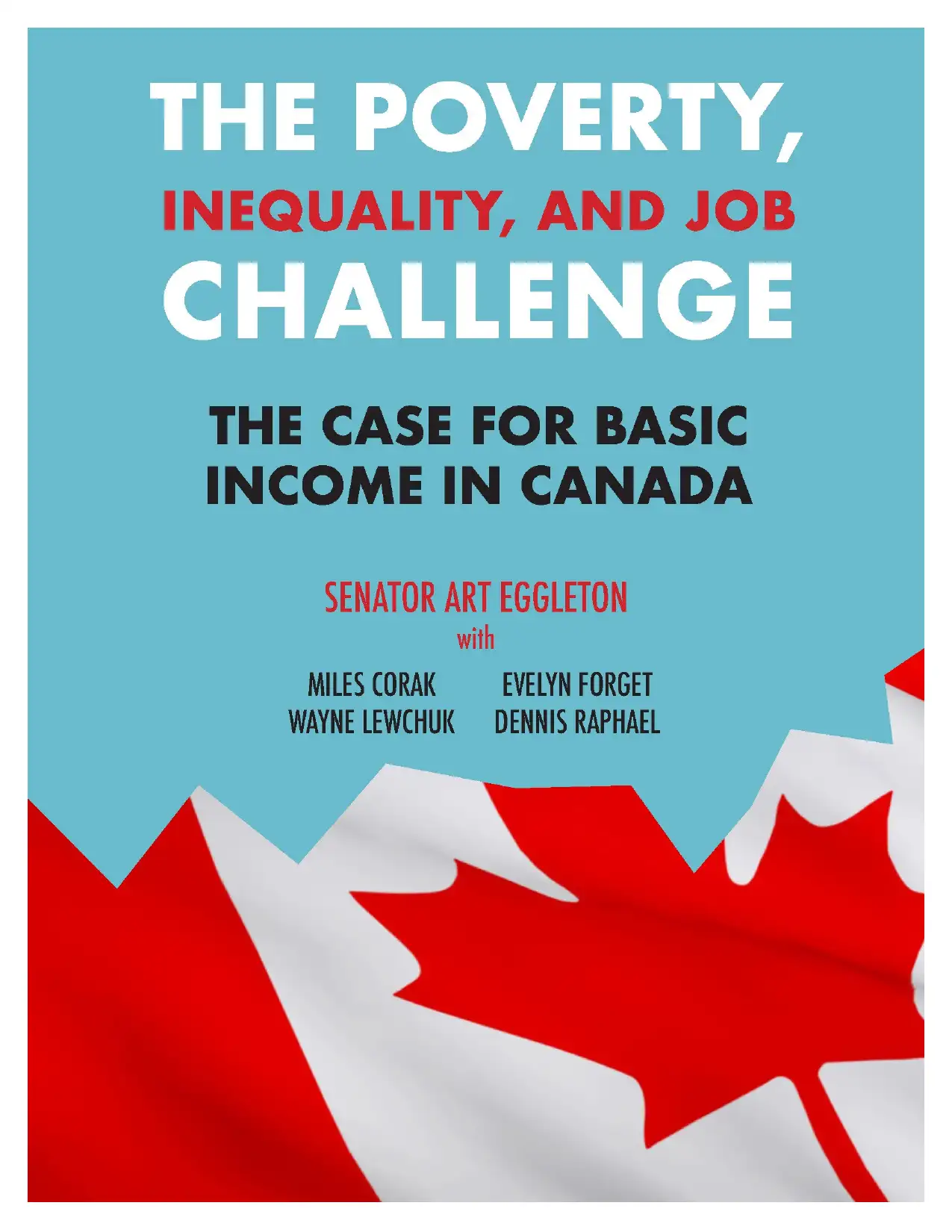
Paraphrase This Document
Need a fresh take? Get an instant paraphrase of this document with our AI Paraphraser
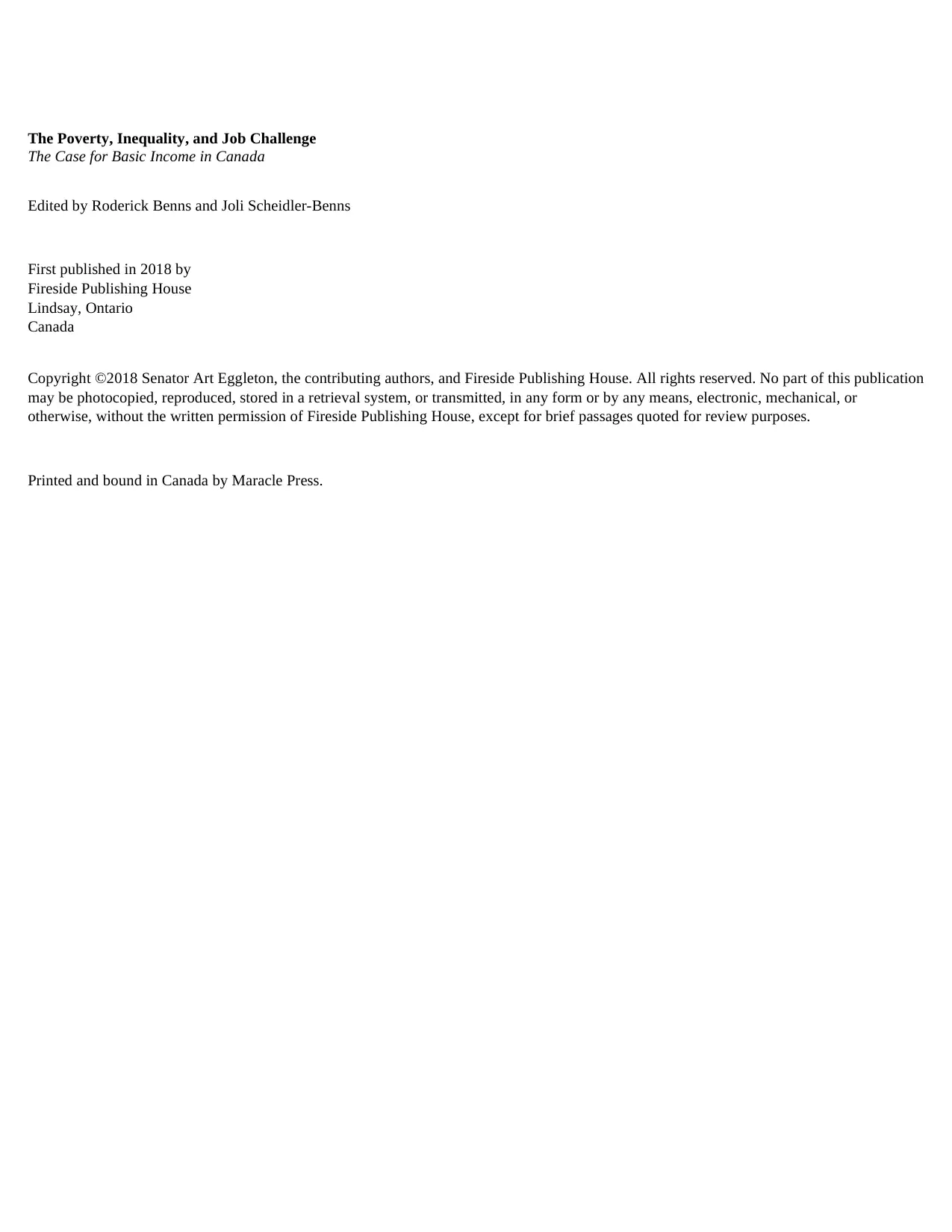
The Poverty, Inequality, and Job Challenge
The Case for Basic Income in Canada
Edited by Roderick Benns and Joli Scheidler-Benns
First published in 2018 by
Fireside Publishing House
Lindsay, Ontario
Canada
Copyright ©2018 Senator Art Eggleton, the contributing authors, and Fireside Publishing House. All rights reserved. No part of this publication
may be photocopied, reproduced, stored in a retrieval system, or transmitted, in any form or by any means, electronic, mechanical, or
otherwise, without the written permission of Fireside Publishing House, except for brief passages quoted for review purposes.
Printed and bound in Canada by Maracle Press.
The Case for Basic Income in Canada
Edited by Roderick Benns and Joli Scheidler-Benns
First published in 2018 by
Fireside Publishing House
Lindsay, Ontario
Canada
Copyright ©2018 Senator Art Eggleton, the contributing authors, and Fireside Publishing House. All rights reserved. No part of this publication
may be photocopied, reproduced, stored in a retrieval system, or transmitted, in any form or by any means, electronic, mechanical, or
otherwise, without the written permission of Fireside Publishing House, except for brief passages quoted for review purposes.
Printed and bound in Canada by Maracle Press.
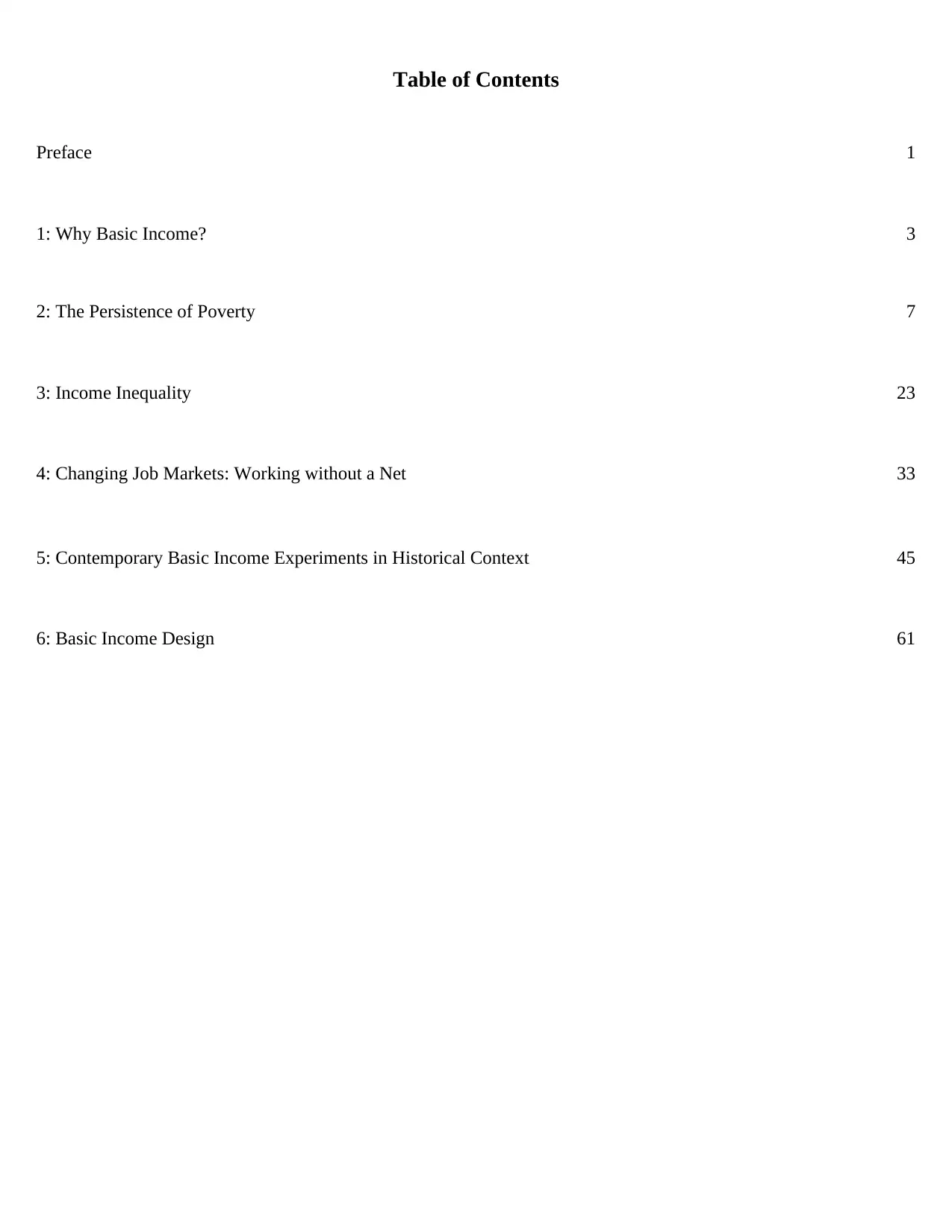
Table of Contents
Preface 1
1: Why Basic Income? 3
2: The Persistence of Poverty 7
3: Income Inequality 23
4: Changing Job Markets: Working without a Net 33
5: Contemporary Basic Income Experiments in Historical Context 45
6: Basic Income Design 61
Preface 1
1: Why Basic Income? 3
2: The Persistence of Poverty 7
3: Income Inequality 23
4: Changing Job Markets: Working without a Net 33
5: Contemporary Basic Income Experiments in Historical Context 45
6: Basic Income Design 61
⊘ This is a preview!⊘
Do you want full access?
Subscribe today to unlock all pages.

Trusted by 1+ million students worldwide
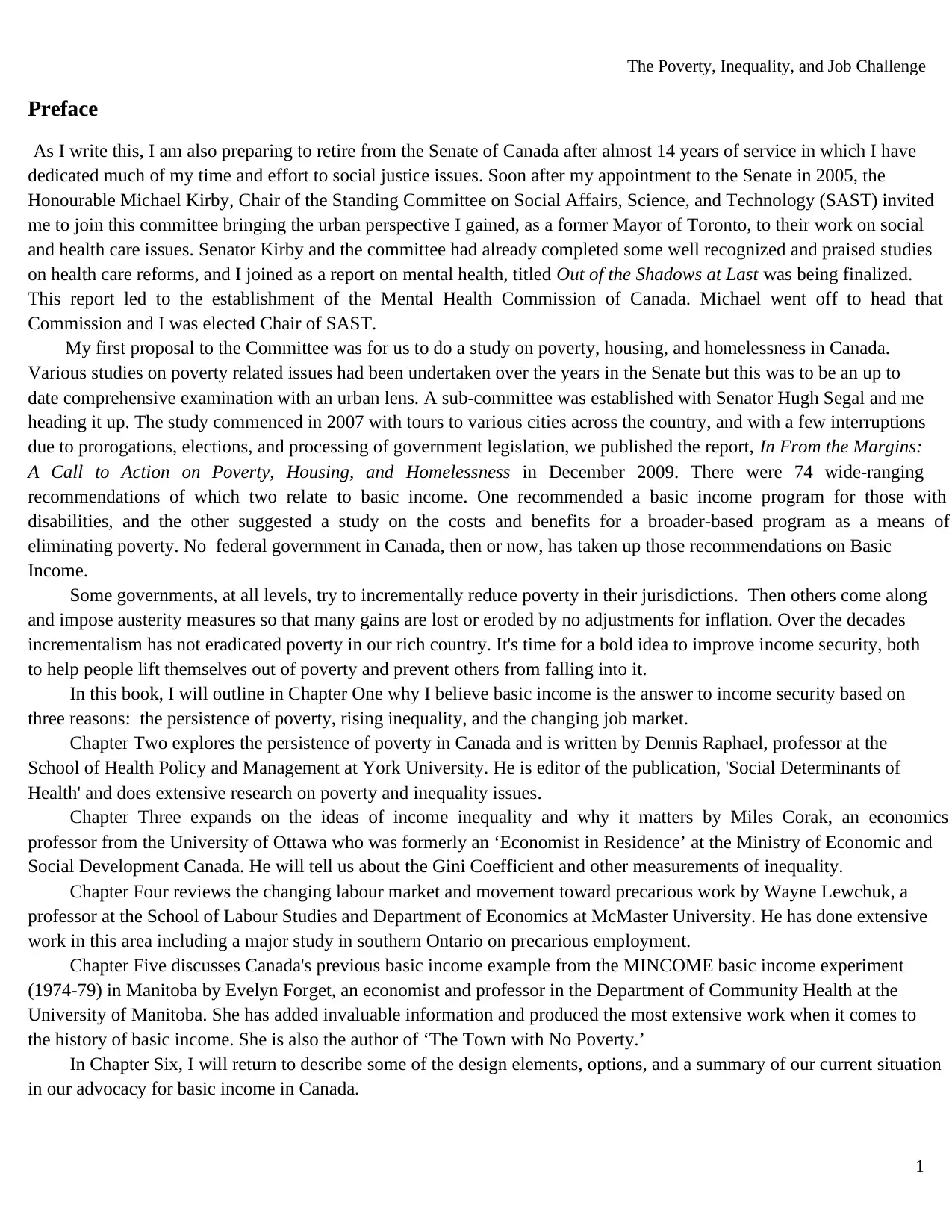
The Poverty, Inequality, and Job Challenge
1
Preface
As I write this, I am also preparing to retire from the Senate of Canada after almost 14 years of service in which I have
dedicated much of my time and effort to social justice issues. Soon after my appointment to the Senate in 2005, the
Honourable Michael Kirby, Chair of the Standing Committee on Social Affairs, Science, and Technology (SAST) invited
me to join this committee bringing the urban perspective I gained, as a former Mayor of Toronto, to their work on social
and health care issues. Senator Kirby and the committee had already completed some well recognized and praised studies
on health care reforms, and I joined as a report on mental health, titled Out of the Shadows at Last was being finalized.
This report led to the establishment of the Mental Health Commission of Canada. Michael went off to head that
Commission and I was elected Chair of SAST.
My first proposal to the Committee was for us to do a study on poverty, housing, and homelessness in Canada.
Various studies on poverty related issues had been undertaken over the years in the Senate but this was to be an up to
date comprehensive examination with an urban lens. A sub-committee was established with Senator Hugh Segal and me
heading it up. The study commenced in 2007 with tours to various cities across the country, and with a few interruptions
due to prorogations, elections, and processing of government legislation, we published the report, In From the Margins:
A Call to Action on Poverty, Housing, and Homelessness in December 2009. There were 74 wide-ranging
recommendations of which two relate to basic income. One recommended a basic income program for those with
disabilities, and the other suggested a study on the costs and benefits for a broader-based program as a means of
eliminating poverty. No federal government in Canada, then or now, has taken up those recommendations on Basic
Income.
Some governments, at all levels, try to incrementally reduce poverty in their jurisdictions. Then others come along
and impose austerity measures so that many gains are lost or eroded by no adjustments for inflation. Over the decades
incrementalism has not eradicated poverty in our rich country. It's time for a bold idea to improve income security, both
to help people lift themselves out of poverty and prevent others from falling into it.
In this book, I will outline in Chapter One why I believe basic income is the answer to income security based on
three reasons: the persistence of poverty, rising inequality, and the changing job market.
Chapter Two explores the persistence of poverty in Canada and is written by Dennis Raphael, professor at the
School of Health Policy and Management at York University. He is editor of the publication, 'Social Determinants of
Health' and does extensive research on poverty and inequality issues.
Chapter Three expands on the ideas of income inequality and why it matters by Miles Corak, an economics
professor from the University of Ottawa who was formerly an ‘Economist in Residence’ at the Ministry of Economic and
Social Development Canada. He will tell us about the Gini Coefficient and other measurements of inequality.
Chapter Four reviews the changing labour market and movement toward precarious work by Wayne Lewchuk, a
professor at the School of Labour Studies and Department of Economics at McMaster University. He has done extensive
work in this area including a major study in southern Ontario on precarious employment.
Chapter Five discusses Canada's previous basic income example from the MINCOME basic income experiment
(1974-79) in Manitoba by Evelyn Forget, an economist and professor in the Department of Community Health at the
University of Manitoba. She has added invaluable information and produced the most extensive work when it comes to
the history of basic income. She is also the author of ‘The Town with No Poverty.’
In Chapter Six, I will return to describe some of the design elements, options, and a summary of our current situation
in our advocacy for basic income in Canada.
1
Preface
As I write this, I am also preparing to retire from the Senate of Canada after almost 14 years of service in which I have
dedicated much of my time and effort to social justice issues. Soon after my appointment to the Senate in 2005, the
Honourable Michael Kirby, Chair of the Standing Committee on Social Affairs, Science, and Technology (SAST) invited
me to join this committee bringing the urban perspective I gained, as a former Mayor of Toronto, to their work on social
and health care issues. Senator Kirby and the committee had already completed some well recognized and praised studies
on health care reforms, and I joined as a report on mental health, titled Out of the Shadows at Last was being finalized.
This report led to the establishment of the Mental Health Commission of Canada. Michael went off to head that
Commission and I was elected Chair of SAST.
My first proposal to the Committee was for us to do a study on poverty, housing, and homelessness in Canada.
Various studies on poverty related issues had been undertaken over the years in the Senate but this was to be an up to
date comprehensive examination with an urban lens. A sub-committee was established with Senator Hugh Segal and me
heading it up. The study commenced in 2007 with tours to various cities across the country, and with a few interruptions
due to prorogations, elections, and processing of government legislation, we published the report, In From the Margins:
A Call to Action on Poverty, Housing, and Homelessness in December 2009. There were 74 wide-ranging
recommendations of which two relate to basic income. One recommended a basic income program for those with
disabilities, and the other suggested a study on the costs and benefits for a broader-based program as a means of
eliminating poverty. No federal government in Canada, then or now, has taken up those recommendations on Basic
Income.
Some governments, at all levels, try to incrementally reduce poverty in their jurisdictions. Then others come along
and impose austerity measures so that many gains are lost or eroded by no adjustments for inflation. Over the decades
incrementalism has not eradicated poverty in our rich country. It's time for a bold idea to improve income security, both
to help people lift themselves out of poverty and prevent others from falling into it.
In this book, I will outline in Chapter One why I believe basic income is the answer to income security based on
three reasons: the persistence of poverty, rising inequality, and the changing job market.
Chapter Two explores the persistence of poverty in Canada and is written by Dennis Raphael, professor at the
School of Health Policy and Management at York University. He is editor of the publication, 'Social Determinants of
Health' and does extensive research on poverty and inequality issues.
Chapter Three expands on the ideas of income inequality and why it matters by Miles Corak, an economics
professor from the University of Ottawa who was formerly an ‘Economist in Residence’ at the Ministry of Economic and
Social Development Canada. He will tell us about the Gini Coefficient and other measurements of inequality.
Chapter Four reviews the changing labour market and movement toward precarious work by Wayne Lewchuk, a
professor at the School of Labour Studies and Department of Economics at McMaster University. He has done extensive
work in this area including a major study in southern Ontario on precarious employment.
Chapter Five discusses Canada's previous basic income example from the MINCOME basic income experiment
(1974-79) in Manitoba by Evelyn Forget, an economist and professor in the Department of Community Health at the
University of Manitoba. She has added invaluable information and produced the most extensive work when it comes to
the history of basic income. She is also the author of ‘The Town with No Poverty.’
In Chapter Six, I will return to describe some of the design elements, options, and a summary of our current situation
in our advocacy for basic income in Canada.
Paraphrase This Document
Need a fresh take? Get an instant paraphrase of this document with our AI Paraphraser
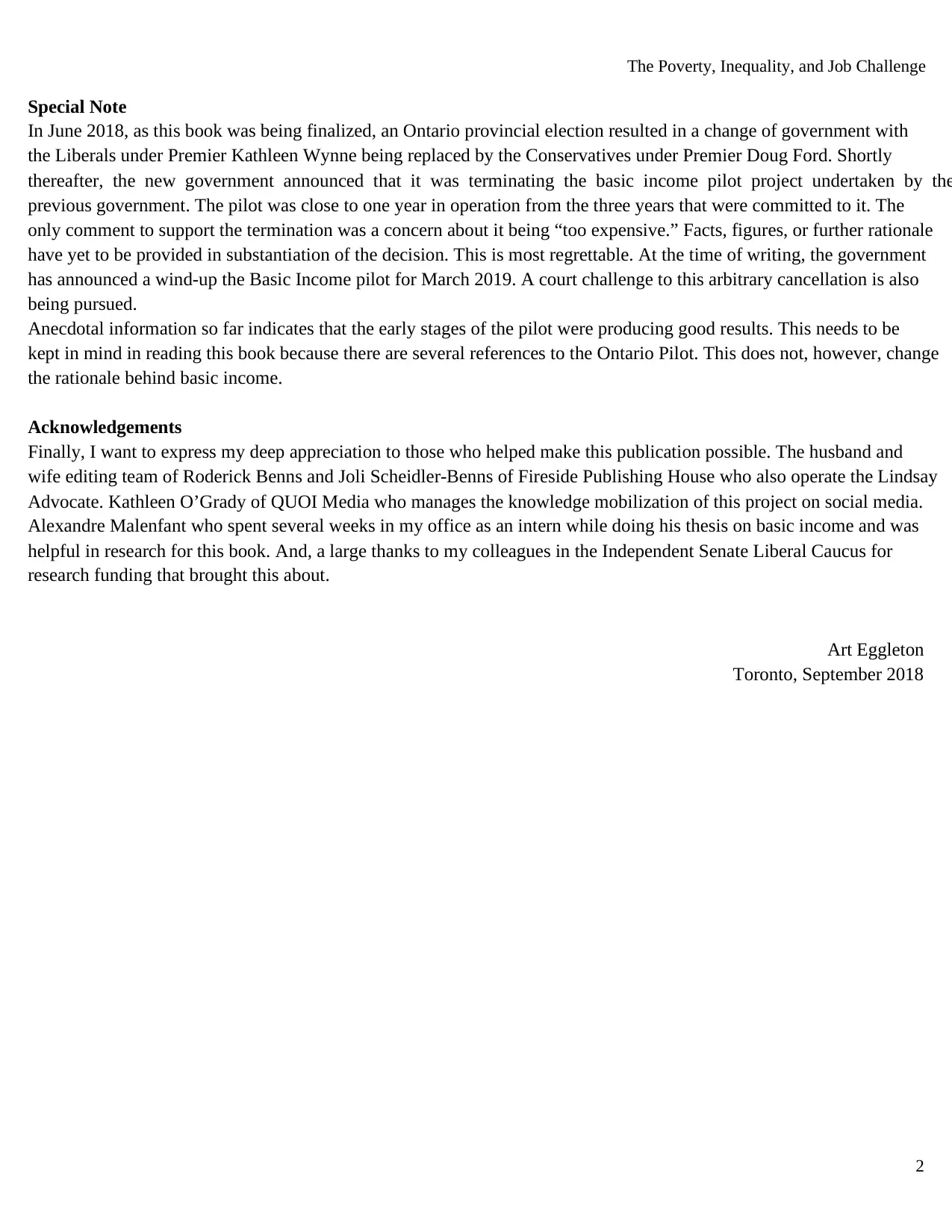
The Poverty, Inequality, and Job Challenge
2
Special Note
In June 2018, as this book was being finalized, an Ontario provincial election resulted in a change of government with
the Liberals under Premier Kathleen Wynne being replaced by the Conservatives under Premier Doug Ford. Shortly
thereafter, the new government announced that it was terminating the basic income pilot project undertaken by the
previous government. The pilot was close to one year in operation from the three years that were committed to it. The
only comment to support the termination was a concern about it being “too expensive.” Facts, figures, or further rationale
have yet to be provided in substantiation of the decision. This is most regrettable. At the time of writing, the government
has announced a wind-up the Basic Income pilot for March 2019. A court challenge to this arbitrary cancellation is also
being pursued.
Anecdotal information so far indicates that the early stages of the pilot were producing good results. This needs to be
kept in mind in reading this book because there are several references to the Ontario Pilot. This does not, however, change
the rationale behind basic income.
Acknowledgements
Finally, I want to express my deep appreciation to those who helped make this publication possible. The husband and
wife editing team of Roderick Benns and Joli Scheidler-Benns of Fireside Publishing House who also operate the Lindsay
Advocate. Kathleen O’Grady of QUOI Media who manages the knowledge mobilization of this project on social media.
Alexandre Malenfant who spent several weeks in my office as an intern while doing his thesis on basic income and was
helpful in research for this book. And, a large thanks to my colleagues in the Independent Senate Liberal Caucus for
research funding that brought this about.
Art Eggleton
Toronto, September 2018
2
Special Note
In June 2018, as this book was being finalized, an Ontario provincial election resulted in a change of government with
the Liberals under Premier Kathleen Wynne being replaced by the Conservatives under Premier Doug Ford. Shortly
thereafter, the new government announced that it was terminating the basic income pilot project undertaken by the
previous government. The pilot was close to one year in operation from the three years that were committed to it. The
only comment to support the termination was a concern about it being “too expensive.” Facts, figures, or further rationale
have yet to be provided in substantiation of the decision. This is most regrettable. At the time of writing, the government
has announced a wind-up the Basic Income pilot for March 2019. A court challenge to this arbitrary cancellation is also
being pursued.
Anecdotal information so far indicates that the early stages of the pilot were producing good results. This needs to be
kept in mind in reading this book because there are several references to the Ontario Pilot. This does not, however, change
the rationale behind basic income.
Acknowledgements
Finally, I want to express my deep appreciation to those who helped make this publication possible. The husband and
wife editing team of Roderick Benns and Joli Scheidler-Benns of Fireside Publishing House who also operate the Lindsay
Advocate. Kathleen O’Grady of QUOI Media who manages the knowledge mobilization of this project on social media.
Alexandre Malenfant who spent several weeks in my office as an intern while doing his thesis on basic income and was
helpful in research for this book. And, a large thanks to my colleagues in the Independent Senate Liberal Caucus for
research funding that brought this about.
Art Eggleton
Toronto, September 2018
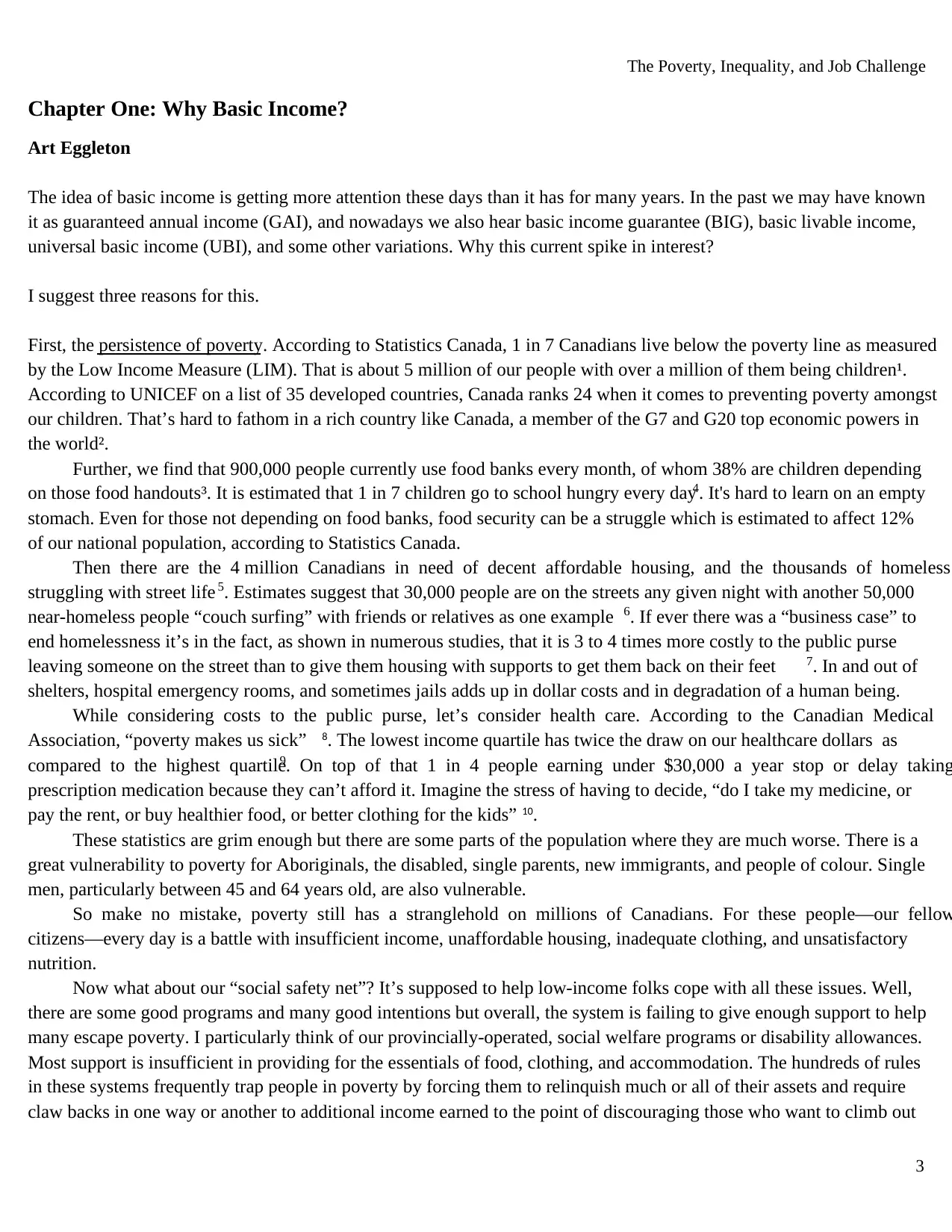
The Poverty, Inequality, and Job Challenge
3
Chapter One: Why Basic Income?
Art Eggleton
The idea of basic income is getting more attention these days than it has for many years. In the past we may have known
it as guaranteed annual income (GAI), and nowadays we also hear basic income guarantee (BIG), basic livable income,
universal basic income (UBI), and some other variations. Why this current spike in interest?
I suggest three reasons for this.
First, the persistence of poverty. According to Statistics Canada, 1 in 7 Canadians live below the poverty line as measured
by the Low Income Measure (LIM). That is about 5 million of our people with over a million of them being children¹.
According to UNICEF on a list of 35 developed countries, Canada ranks 24 when it comes to preventing poverty amongst
our children. That’s hard to fathom in a rich country like Canada, a member of the G7 and G20 top economic powers in
the world².
Further, we find that 900,000 people currently use food banks every month, of whom 38% are children depending
on those food handouts³. It is estimated that 1 in 7 children go to school hungry every day4. It's hard to learn on an empty
stomach. Even for those not depending on food banks, food security can be a struggle which is estimated to affect 12%
of our national population, according to Statistics Canada.
Then there are the 4 million Canadians in need of decent affordable housing, and the thousands of homeless
struggling with street life 5. Estimates suggest that 30,000 people are on the streets any given night with another 50,000
near-homeless people “couch surfing” with friends or relatives as one example 6. If ever there was a “business case” to
end homelessness it’s in the fact, as shown in numerous studies, that it is 3 to 4 times more costly to the public purse
leaving someone on the street than to give them housing with supports to get them back on their feet 7. In and out of
shelters, hospital emergency rooms, and sometimes jails adds up in dollar costs and in degradation of a human being.
While considering costs to the public purse, let’s consider health care. According to the Canadian Medical
Association, “poverty makes us sick” 8. The lowest income quartile has twice the draw on our healthcare dollars as
compared to the highest quartile9. On top of that 1 in 4 people earning under $30,000 a year stop or delay taking
prescription medication because they can’t afford it. Imagine the stress of having to decide, “do I take my medicine, or
pay the rent, or buy healthier food, or better clothing for the kids” 10.
These statistics are grim enough but there are some parts of the population where they are much worse. There is a
great vulnerability to poverty for Aboriginals, the disabled, single parents, new immigrants, and people of colour. Single
men, particularly between 45 and 64 years old, are also vulnerable.
So make no mistake, poverty still has a stranglehold on millions of Canadians. For these people—our fellow
citizens—every day is a battle with insufficient income, unaffordable housing, inadequate clothing, and unsatisfactory
nutrition.
Now what about our “social safety net”? It’s supposed to help low-income folks cope with all these issues. Well,
there are some good programs and many good intentions but overall, the system is failing to give enough support to help
many escape poverty. I particularly think of our provincially-operated, social welfare programs or disability allowances.
Most support is insufficient in providing for the essentials of food, clothing, and accommodation. The hundreds of rules
in these systems frequently trap people in poverty by forcing them to relinquish much or all of their assets and require
claw backs in one way or another to additional income earned to the point of discouraging those who want to climb out
3
Chapter One: Why Basic Income?
Art Eggleton
The idea of basic income is getting more attention these days than it has for many years. In the past we may have known
it as guaranteed annual income (GAI), and nowadays we also hear basic income guarantee (BIG), basic livable income,
universal basic income (UBI), and some other variations. Why this current spike in interest?
I suggest three reasons for this.
First, the persistence of poverty. According to Statistics Canada, 1 in 7 Canadians live below the poverty line as measured
by the Low Income Measure (LIM). That is about 5 million of our people with over a million of them being children¹.
According to UNICEF on a list of 35 developed countries, Canada ranks 24 when it comes to preventing poverty amongst
our children. That’s hard to fathom in a rich country like Canada, a member of the G7 and G20 top economic powers in
the world².
Further, we find that 900,000 people currently use food banks every month, of whom 38% are children depending
on those food handouts³. It is estimated that 1 in 7 children go to school hungry every day4. It's hard to learn on an empty
stomach. Even for those not depending on food banks, food security can be a struggle which is estimated to affect 12%
of our national population, according to Statistics Canada.
Then there are the 4 million Canadians in need of decent affordable housing, and the thousands of homeless
struggling with street life 5. Estimates suggest that 30,000 people are on the streets any given night with another 50,000
near-homeless people “couch surfing” with friends or relatives as one example 6. If ever there was a “business case” to
end homelessness it’s in the fact, as shown in numerous studies, that it is 3 to 4 times more costly to the public purse
leaving someone on the street than to give them housing with supports to get them back on their feet 7. In and out of
shelters, hospital emergency rooms, and sometimes jails adds up in dollar costs and in degradation of a human being.
While considering costs to the public purse, let’s consider health care. According to the Canadian Medical
Association, “poverty makes us sick” 8. The lowest income quartile has twice the draw on our healthcare dollars as
compared to the highest quartile9. On top of that 1 in 4 people earning under $30,000 a year stop or delay taking
prescription medication because they can’t afford it. Imagine the stress of having to decide, “do I take my medicine, or
pay the rent, or buy healthier food, or better clothing for the kids” 10.
These statistics are grim enough but there are some parts of the population where they are much worse. There is a
great vulnerability to poverty for Aboriginals, the disabled, single parents, new immigrants, and people of colour. Single
men, particularly between 45 and 64 years old, are also vulnerable.
So make no mistake, poverty still has a stranglehold on millions of Canadians. For these people—our fellow
citizens—every day is a battle with insufficient income, unaffordable housing, inadequate clothing, and unsatisfactory
nutrition.
Now what about our “social safety net”? It’s supposed to help low-income folks cope with all these issues. Well,
there are some good programs and many good intentions but overall, the system is failing to give enough support to help
many escape poverty. I particularly think of our provincially-operated, social welfare programs or disability allowances.
Most support is insufficient in providing for the essentials of food, clothing, and accommodation. The hundreds of rules
in these systems frequently trap people in poverty by forcing them to relinquish much or all of their assets and require
claw backs in one way or another to additional income earned to the point of discouraging those who want to climb out
⊘ This is a preview!⊘
Do you want full access?
Subscribe today to unlock all pages.

Trusted by 1+ million students worldwide
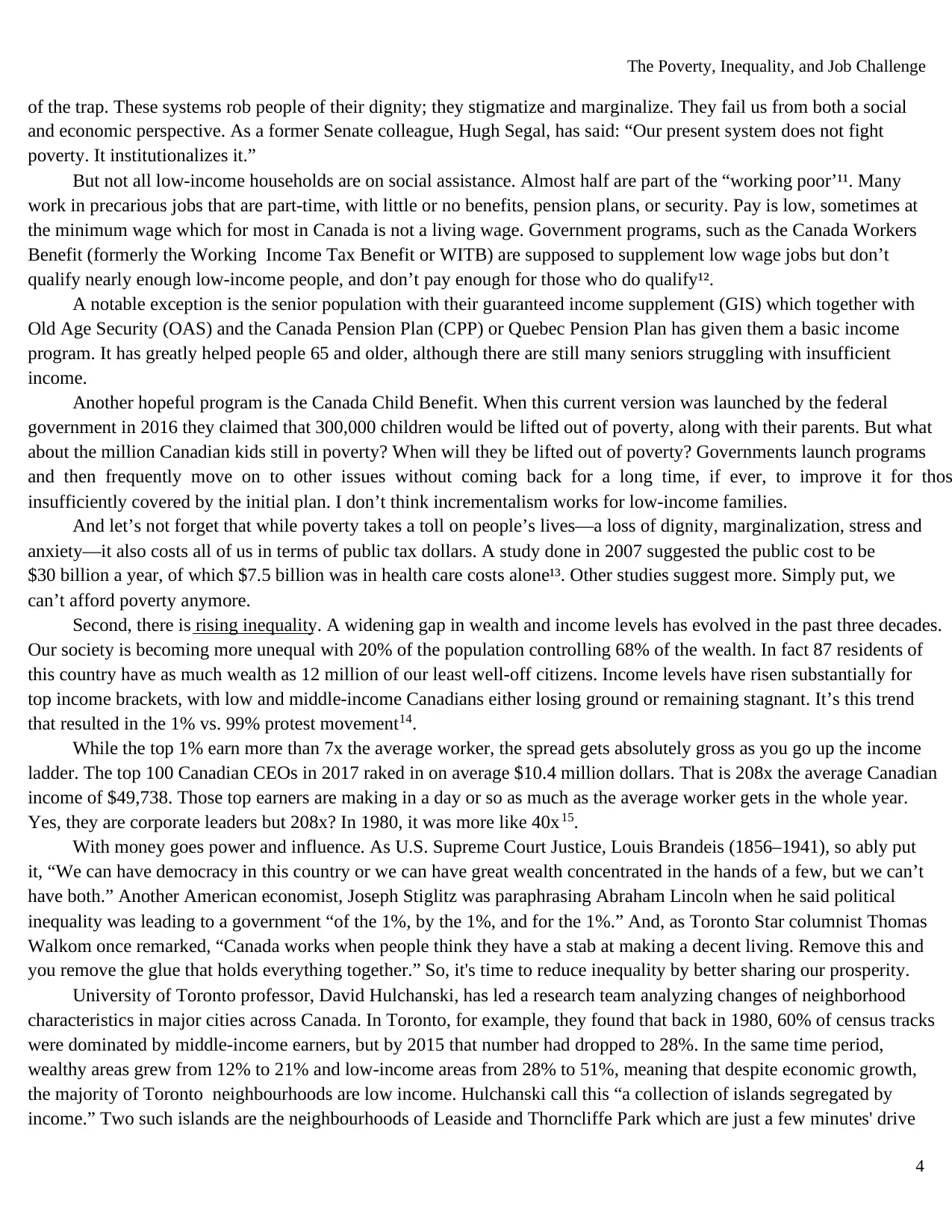
The Poverty, Inequality, and Job Challenge
4
of the trap. These systems rob people of their dignity; they stigmatize and marginalize. They fail us from both a social
and economic perspective. As a former Senate colleague, Hugh Segal, has said: “Our present system does not fight
poverty. It institutionalizes it.”
But not all low-income households are on social assistance. Almost half are part of the “working poor’¹¹. Many
work in precarious jobs that are part-time, with little or no benefits, pension plans, or security. Pay is low, sometimes at
the minimum wage which for most in Canada is not a living wage. Government programs, such as the Canada Workers
Benefit (formerly the Working Income Tax Benefit or WITB) are supposed to supplement low wage jobs but don’t
qualify nearly enough low-income people, and don’t pay enough for those who do qualify¹².
A notable exception is the senior population with their guaranteed income supplement (GIS) which together with
Old Age Security (OAS) and the Canada Pension Plan (CPP) or Quebec Pension Plan has given them a basic income
program. It has greatly helped people 65 and older, although there are still many seniors struggling with insufficient
income.
Another hopeful program is the Canada Child Benefit. When this current version was launched by the federal
government in 2016 they claimed that 300,000 children would be lifted out of poverty, along with their parents. But what
about the million Canadian kids still in poverty? When will they be lifted out of poverty? Governments launch programs
and then frequently move on to other issues without coming back for a long time, if ever, to improve it for thos
insufficiently covered by the initial plan. I don’t think incrementalism works for low-income families.
And let’s not forget that while poverty takes a toll on people’s lives—a loss of dignity, marginalization, stress and
anxiety—it also costs all of us in terms of public tax dollars. A study done in 2007 suggested the public cost to be
$30 billion a year, of which $7.5 billion was in health care costs alone¹³. Other studies suggest more. Simply put, we
can’t afford poverty anymore.
Second, there is rising inequality. A widening gap in wealth and income levels has evolved in the past three decades.
Our society is becoming more unequal with 20% of the population controlling 68% of the wealth. In fact 87 residents of
this country have as much wealth as 12 million of our least well-off citizens. Income levels have risen substantially for
top income brackets, with low and middle-income Canadians either losing ground or remaining stagnant. It’s this trend
that resulted in the 1% vs. 99% protest movement14.
While the top 1% earn more than 7x the average worker, the spread gets absolutely gross as you go up the income
ladder. The top 100 Canadian CEOs in 2017 raked in on average $10.4 million dollars. That is 208x the average Canadian
income of $49,738. Those top earners are making in a day or so as much as the average worker gets in the whole year.
Yes, they are corporate leaders but 208x? In 1980, it was more like 40x15.
With money goes power and influence. As U.S. Supreme Court Justice, Louis Brandeis (1856–1941), so ably put
it, “We can have democracy in this country or we can have great wealth concentrated in the hands of a few, but we can’t
have both.” Another American economist, Joseph Stiglitz was paraphrasing Abraham Lincoln when he said political
inequality was leading to a government “of the 1%, by the 1%, and for the 1%.” And, as Toronto Star columnist Thomas
Walkom once remarked, “Canada works when people think they have a stab at making a decent living. Remove this and
you remove the glue that holds everything together.” So, it's time to reduce inequality by better sharing our prosperity.
University of Toronto professor, David Hulchanski, has led a research team analyzing changes of neighborhood
characteristics in major cities across Canada. In Toronto, for example, they found that back in 1980, 60% of census tracks
were dominated by middle-income earners, but by 2015 that number had dropped to 28%. In the same time period,
wealthy areas grew from 12% to 21% and low-income areas from 28% to 51%, meaning that despite economic growth,
the majority of Toronto neighbourhoods are low income. Hulchanski call this “a collection of islands segregated by
income.” Two such islands are the neighbourhoods of Leaside and Thorncliffe Park which are just a few minutes' drive
4
of the trap. These systems rob people of their dignity; they stigmatize and marginalize. They fail us from both a social
and economic perspective. As a former Senate colleague, Hugh Segal, has said: “Our present system does not fight
poverty. It institutionalizes it.”
But not all low-income households are on social assistance. Almost half are part of the “working poor’¹¹. Many
work in precarious jobs that are part-time, with little or no benefits, pension plans, or security. Pay is low, sometimes at
the minimum wage which for most in Canada is not a living wage. Government programs, such as the Canada Workers
Benefit (formerly the Working Income Tax Benefit or WITB) are supposed to supplement low wage jobs but don’t
qualify nearly enough low-income people, and don’t pay enough for those who do qualify¹².
A notable exception is the senior population with their guaranteed income supplement (GIS) which together with
Old Age Security (OAS) and the Canada Pension Plan (CPP) or Quebec Pension Plan has given them a basic income
program. It has greatly helped people 65 and older, although there are still many seniors struggling with insufficient
income.
Another hopeful program is the Canada Child Benefit. When this current version was launched by the federal
government in 2016 they claimed that 300,000 children would be lifted out of poverty, along with their parents. But what
about the million Canadian kids still in poverty? When will they be lifted out of poverty? Governments launch programs
and then frequently move on to other issues without coming back for a long time, if ever, to improve it for thos
insufficiently covered by the initial plan. I don’t think incrementalism works for low-income families.
And let’s not forget that while poverty takes a toll on people’s lives—a loss of dignity, marginalization, stress and
anxiety—it also costs all of us in terms of public tax dollars. A study done in 2007 suggested the public cost to be
$30 billion a year, of which $7.5 billion was in health care costs alone¹³. Other studies suggest more. Simply put, we
can’t afford poverty anymore.
Second, there is rising inequality. A widening gap in wealth and income levels has evolved in the past three decades.
Our society is becoming more unequal with 20% of the population controlling 68% of the wealth. In fact 87 residents of
this country have as much wealth as 12 million of our least well-off citizens. Income levels have risen substantially for
top income brackets, with low and middle-income Canadians either losing ground or remaining stagnant. It’s this trend
that resulted in the 1% vs. 99% protest movement14.
While the top 1% earn more than 7x the average worker, the spread gets absolutely gross as you go up the income
ladder. The top 100 Canadian CEOs in 2017 raked in on average $10.4 million dollars. That is 208x the average Canadian
income of $49,738. Those top earners are making in a day or so as much as the average worker gets in the whole year.
Yes, they are corporate leaders but 208x? In 1980, it was more like 40x15.
With money goes power and influence. As U.S. Supreme Court Justice, Louis Brandeis (1856–1941), so ably put
it, “We can have democracy in this country or we can have great wealth concentrated in the hands of a few, but we can’t
have both.” Another American economist, Joseph Stiglitz was paraphrasing Abraham Lincoln when he said political
inequality was leading to a government “of the 1%, by the 1%, and for the 1%.” And, as Toronto Star columnist Thomas
Walkom once remarked, “Canada works when people think they have a stab at making a decent living. Remove this and
you remove the glue that holds everything together.” So, it's time to reduce inequality by better sharing our prosperity.
University of Toronto professor, David Hulchanski, has led a research team analyzing changes of neighborhood
characteristics in major cities across Canada. In Toronto, for example, they found that back in 1980, 60% of census tracks
were dominated by middle-income earners, but by 2015 that number had dropped to 28%. In the same time period,
wealthy areas grew from 12% to 21% and low-income areas from 28% to 51%, meaning that despite economic growth,
the majority of Toronto neighbourhoods are low income. Hulchanski call this “a collection of islands segregated by
income.” Two such islands are the neighbourhoods of Leaside and Thorncliffe Park which are just a few minutes' drive
Paraphrase This Document
Need a fresh take? Get an instant paraphrase of this document with our AI Paraphraser
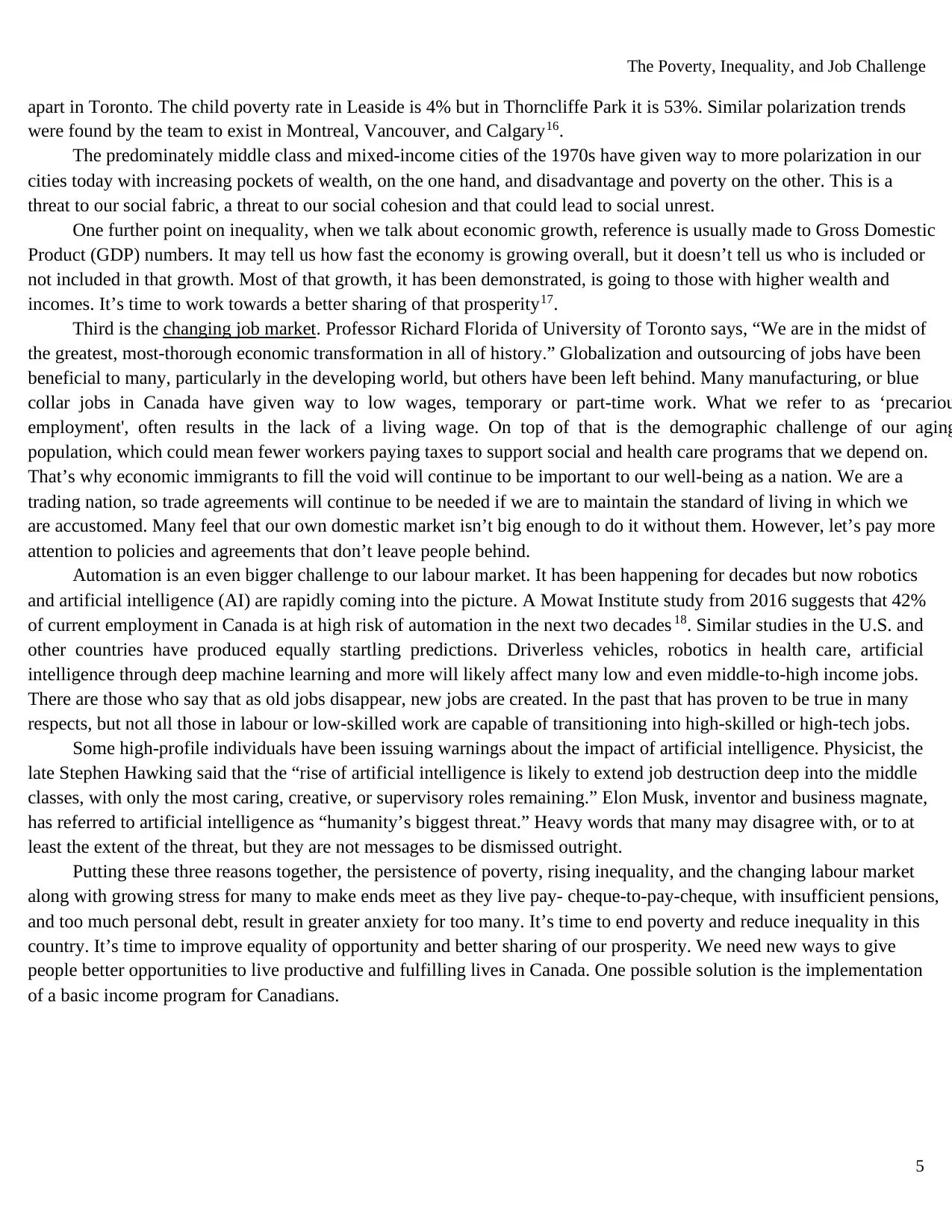
The Poverty, Inequality, and Job Challenge
5
apart in Toronto. The child poverty rate in Leaside is 4% but in Thorncliffe Park it is 53%. Similar polarization trends
were found by the team to exist in Montreal, Vancouver, and Calgary16.
The predominately middle class and mixed-income cities of the 1970s have given way to more polarization in our
cities today with increasing pockets of wealth, on the one hand, and disadvantage and poverty on the other. This is a
threat to our social fabric, a threat to our social cohesion and that could lead to social unrest.
One further point on inequality, when we talk about economic growth, reference is usually made to Gross Domestic
Product (GDP) numbers. It may tell us how fast the economy is growing overall, but it doesn’t tell us who is included or
not included in that growth. Most of that growth, it has been demonstrated, is going to those with higher wealth and
incomes. It’s time to work towards a better sharing of that prosperity17.
Third is the changing job market. Professor Richard Florida of University of Toronto says, “We are in the midst of
the greatest, most-thorough economic transformation in all of history.” Globalization and outsourcing of jobs have been
beneficial to many, particularly in the developing world, but others have been left behind. Many manufacturing, or blue
collar jobs in Canada have given way to low wages, temporary or part-time work. What we refer to as ‘precariou
employment', often results in the lack of a living wage. On top of that is the demographic challenge of our aging
population, which could mean fewer workers paying taxes to support social and health care programs that we depend on.
That’s why economic immigrants to fill the void will continue to be important to our well-being as a nation. We are a
trading nation, so trade agreements will continue to be needed if we are to maintain the standard of living in which we
are accustomed. Many feel that our own domestic market isn’t big enough to do it without them. However, let’s pay more
attention to policies and agreements that don’t leave people behind.
Automation is an even bigger challenge to our labour market. It has been happening for decades but now robotics
and artificial intelligence (AI) are rapidly coming into the picture. A Mowat Institute study from 2016 suggests that 42%
of current employment in Canada is at high risk of automation in the next two decades 18. Similar studies in the U.S. and
other countries have produced equally startling predictions. Driverless vehicles, robotics in health care, artificial
intelligence through deep machine learning and more will likely affect many low and even middle-to-high income jobs.
There are those who say that as old jobs disappear, new jobs are created. In the past that has proven to be true in many
respects, but not all those in labour or low-skilled work are capable of transitioning into high-skilled or high-tech jobs.
Some high-profile individuals have been issuing warnings about the impact of artificial intelligence. Physicist, the
late Stephen Hawking said that the “rise of artificial intelligence is likely to extend job destruction deep into the middle
classes, with only the most caring, creative, or supervisory roles remaining.” Elon Musk, inventor and business magnate,
has referred to artificial intelligence as “humanity’s biggest threat.” Heavy words that many may disagree with, or to at
least the extent of the threat, but they are not messages to be dismissed outright.
Putting these three reasons together, the persistence of poverty, rising inequality, and the changing labour market
along with growing stress for many to make ends meet as they live pay- cheque-to-pay-cheque, with insufficient pensions,
and too much personal debt, result in greater anxiety for too many. It’s time to end poverty and reduce inequality in this
country. It’s time to improve equality of opportunity and better sharing of our prosperity. We need new ways to give
people better opportunities to live productive and fulfilling lives in Canada. One possible solution is the implementation
of a basic income program for Canadians.
5
apart in Toronto. The child poverty rate in Leaside is 4% but in Thorncliffe Park it is 53%. Similar polarization trends
were found by the team to exist in Montreal, Vancouver, and Calgary16.
The predominately middle class and mixed-income cities of the 1970s have given way to more polarization in our
cities today with increasing pockets of wealth, on the one hand, and disadvantage and poverty on the other. This is a
threat to our social fabric, a threat to our social cohesion and that could lead to social unrest.
One further point on inequality, when we talk about economic growth, reference is usually made to Gross Domestic
Product (GDP) numbers. It may tell us how fast the economy is growing overall, but it doesn’t tell us who is included or
not included in that growth. Most of that growth, it has been demonstrated, is going to those with higher wealth and
incomes. It’s time to work towards a better sharing of that prosperity17.
Third is the changing job market. Professor Richard Florida of University of Toronto says, “We are in the midst of
the greatest, most-thorough economic transformation in all of history.” Globalization and outsourcing of jobs have been
beneficial to many, particularly in the developing world, but others have been left behind. Many manufacturing, or blue
collar jobs in Canada have given way to low wages, temporary or part-time work. What we refer to as ‘precariou
employment', often results in the lack of a living wage. On top of that is the demographic challenge of our aging
population, which could mean fewer workers paying taxes to support social and health care programs that we depend on.
That’s why economic immigrants to fill the void will continue to be important to our well-being as a nation. We are a
trading nation, so trade agreements will continue to be needed if we are to maintain the standard of living in which we
are accustomed. Many feel that our own domestic market isn’t big enough to do it without them. However, let’s pay more
attention to policies and agreements that don’t leave people behind.
Automation is an even bigger challenge to our labour market. It has been happening for decades but now robotics
and artificial intelligence (AI) are rapidly coming into the picture. A Mowat Institute study from 2016 suggests that 42%
of current employment in Canada is at high risk of automation in the next two decades 18. Similar studies in the U.S. and
other countries have produced equally startling predictions. Driverless vehicles, robotics in health care, artificial
intelligence through deep machine learning and more will likely affect many low and even middle-to-high income jobs.
There are those who say that as old jobs disappear, new jobs are created. In the past that has proven to be true in many
respects, but not all those in labour or low-skilled work are capable of transitioning into high-skilled or high-tech jobs.
Some high-profile individuals have been issuing warnings about the impact of artificial intelligence. Physicist, the
late Stephen Hawking said that the “rise of artificial intelligence is likely to extend job destruction deep into the middle
classes, with only the most caring, creative, or supervisory roles remaining.” Elon Musk, inventor and business magnate,
has referred to artificial intelligence as “humanity’s biggest threat.” Heavy words that many may disagree with, or to at
least the extent of the threat, but they are not messages to be dismissed outright.
Putting these three reasons together, the persistence of poverty, rising inequality, and the changing labour market
along with growing stress for many to make ends meet as they live pay- cheque-to-pay-cheque, with insufficient pensions,
and too much personal debt, result in greater anxiety for too many. It’s time to end poverty and reduce inequality in this
country. It’s time to improve equality of opportunity and better sharing of our prosperity. We need new ways to give
people better opportunities to live productive and fulfilling lives in Canada. One possible solution is the implementation
of a basic income program for Canadians.
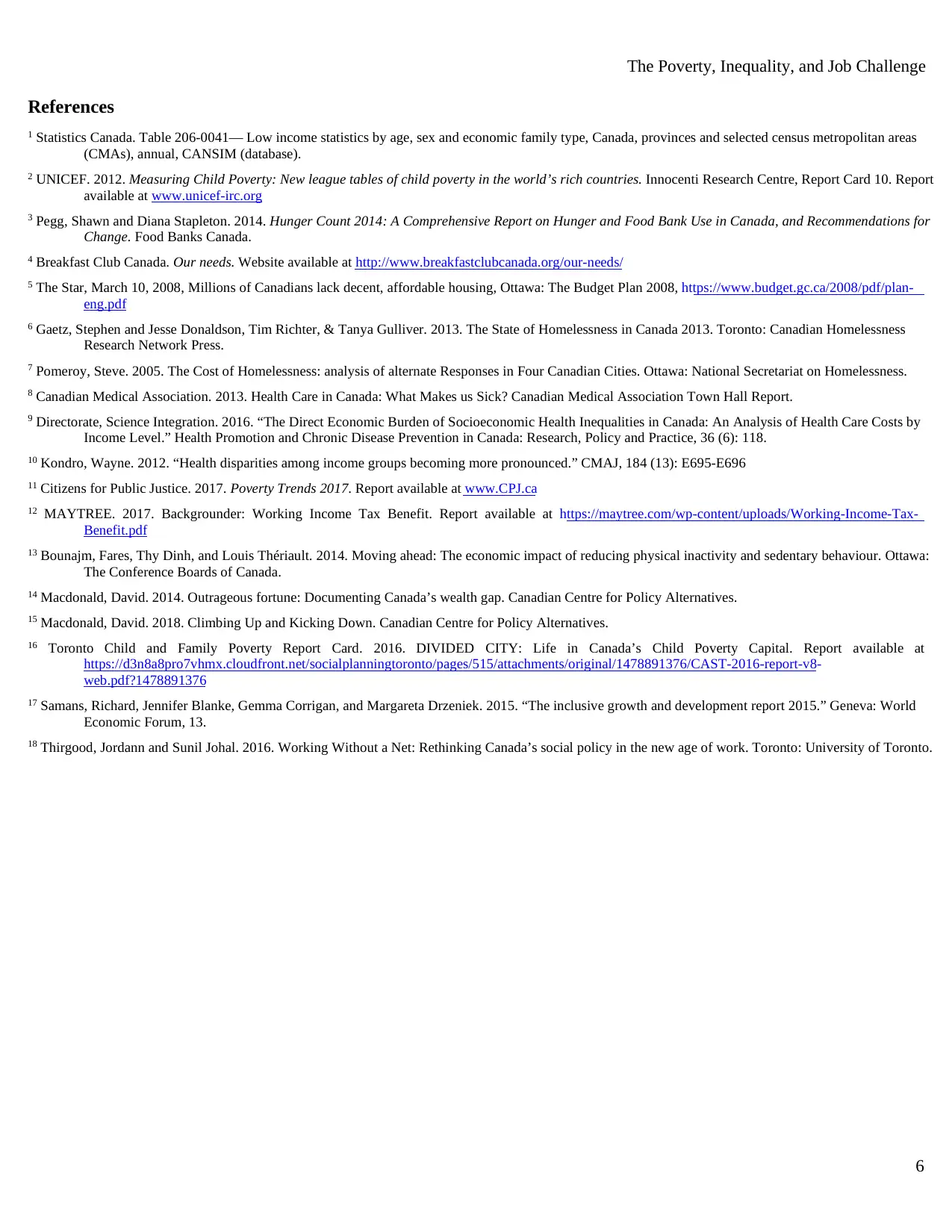
The Poverty, Inequality, and Job Challenge
6
References
1 Statistics Canada. Table 206-0041— Low income statistics by age, sex and economic family type, Canada, provinces and selected census metropolitan areas
(CMAs), annual, CANSIM (database).
2 UNICEF. 2012. Measuring Child Poverty: New league tables of child poverty in the world’s rich countries. Innocenti Research Centre, Report Card 10. Report
available at www.unicef-irc.org
3 Pegg, Shawn and Diana Stapleton. 2014. Hunger Count 2014: A Comprehensive Report on Hunger and Food Bank Use in Canada, and Recommendations for
Change. Food Banks Canada.
4 Breakfast Club Canada. Our needs. Website available at http://www.breakfastclubcanada.org/our-needs/
5 The Star, March 10, 2008, Millions of Canadians lack decent, affordable housing, Ottawa: The Budget Plan 2008, https://www.budget.gc.ca/2008/pdf/plan-
eng.pdf
6 Gaetz, Stephen and Jesse Donaldson, Tim Richter, & Tanya Gulliver. 2013. The State of Homelessness in Canada 2013. Toronto: Canadian Homelessness
Research Network Press.
7 Pomeroy, Steve. 2005. The Cost of Homelessness: analysis of alternate Responses in Four Canadian Cities. Ottawa: National Secretariat on Homelessness.
8 Canadian Medical Association. 2013. Health Care in Canada: What Makes us Sick? Canadian Medical Association Town Hall Report.
9 Directorate, Science Integration. 2016. “The Direct Economic Burden of Socioeconomic Health Inequalities in Canada: An Analysis of Health Care Costs by
Income Level.” Health Promotion and Chronic Disease Prevention in Canada: Research, Policy and Practice, 36 (6): 118.
10 Kondro, Wayne. 2012. “Health disparities among income groups becoming more pronounced.” CMAJ, 184 (13): E695-E696
11 Citizens for Public Justice. 2017. Poverty Trends 2017. Report available at www.CPJ.ca
12 MAYTREE. 2017. Backgrounder: Working Income Tax Benefit. Report available at https://maytree.com/wp-content/uploads/Working-Income-Tax-
Benefit.pdf
13 Bounajm, Fares, Thy Dinh, and Louis Thériault. 2014. Moving ahead: The economic impact of reducing physical inactivity and sedentary behaviour. Ottawa:
The Conference Boards of Canada.
14 Macdonald, David. 2014. Outrageous fortune: Documenting Canada’s wealth gap. Canadian Centre for Policy Alternatives.
15 Macdonald, David. 2018. Climbing Up and Kicking Down. Canadian Centre for Policy Alternatives.
16 Toronto Child and Family Poverty Report Card. 2016. DIVIDED CITY: Life in Canada’s Child Poverty Capital. Report available at
https://d3n8a8pro7vhmx.cloudfront.net/socialplanningtoronto/pages/515/attachments/original/1478891376/CAST-2016-report-v8-
web.pdf?1478891376
17 Samans, Richard, Jennifer Blanke, Gemma Corrigan, and Margareta Drzeniek. 2015. “The inclusive growth and development report 2015.” Geneva: World
Economic Forum, 13.
18 Thirgood, Jordann and Sunil Johal. 2016. Working Without a Net: Rethinking Canada’s social policy in the new age of work. Toronto: University of Toronto.
6
References
1 Statistics Canada. Table 206-0041— Low income statistics by age, sex and economic family type, Canada, provinces and selected census metropolitan areas
(CMAs), annual, CANSIM (database).
2 UNICEF. 2012. Measuring Child Poverty: New league tables of child poverty in the world’s rich countries. Innocenti Research Centre, Report Card 10. Report
available at www.unicef-irc.org
3 Pegg, Shawn and Diana Stapleton. 2014. Hunger Count 2014: A Comprehensive Report on Hunger and Food Bank Use in Canada, and Recommendations for
Change. Food Banks Canada.
4 Breakfast Club Canada. Our needs. Website available at http://www.breakfastclubcanada.org/our-needs/
5 The Star, March 10, 2008, Millions of Canadians lack decent, affordable housing, Ottawa: The Budget Plan 2008, https://www.budget.gc.ca/2008/pdf/plan-
eng.pdf
6 Gaetz, Stephen and Jesse Donaldson, Tim Richter, & Tanya Gulliver. 2013. The State of Homelessness in Canada 2013. Toronto: Canadian Homelessness
Research Network Press.
7 Pomeroy, Steve. 2005. The Cost of Homelessness: analysis of alternate Responses in Four Canadian Cities. Ottawa: National Secretariat on Homelessness.
8 Canadian Medical Association. 2013. Health Care in Canada: What Makes us Sick? Canadian Medical Association Town Hall Report.
9 Directorate, Science Integration. 2016. “The Direct Economic Burden of Socioeconomic Health Inequalities in Canada: An Analysis of Health Care Costs by
Income Level.” Health Promotion and Chronic Disease Prevention in Canada: Research, Policy and Practice, 36 (6): 118.
10 Kondro, Wayne. 2012. “Health disparities among income groups becoming more pronounced.” CMAJ, 184 (13): E695-E696
11 Citizens for Public Justice. 2017. Poverty Trends 2017. Report available at www.CPJ.ca
12 MAYTREE. 2017. Backgrounder: Working Income Tax Benefit. Report available at https://maytree.com/wp-content/uploads/Working-Income-Tax-
Benefit.pdf
13 Bounajm, Fares, Thy Dinh, and Louis Thériault. 2014. Moving ahead: The economic impact of reducing physical inactivity and sedentary behaviour. Ottawa:
The Conference Boards of Canada.
14 Macdonald, David. 2014. Outrageous fortune: Documenting Canada’s wealth gap. Canadian Centre for Policy Alternatives.
15 Macdonald, David. 2018. Climbing Up and Kicking Down. Canadian Centre for Policy Alternatives.
16 Toronto Child and Family Poverty Report Card. 2016. DIVIDED CITY: Life in Canada’s Child Poverty Capital. Report available at
https://d3n8a8pro7vhmx.cloudfront.net/socialplanningtoronto/pages/515/attachments/original/1478891376/CAST-2016-report-v8-
web.pdf?1478891376
17 Samans, Richard, Jennifer Blanke, Gemma Corrigan, and Margareta Drzeniek. 2015. “The inclusive growth and development report 2015.” Geneva: World
Economic Forum, 13.
18 Thirgood, Jordann and Sunil Johal. 2016. Working Without a Net: Rethinking Canada’s social policy in the new age of work. Toronto: University of Toronto.
⊘ This is a preview!⊘
Do you want full access?
Subscribe today to unlock all pages.

Trusted by 1+ million students worldwide
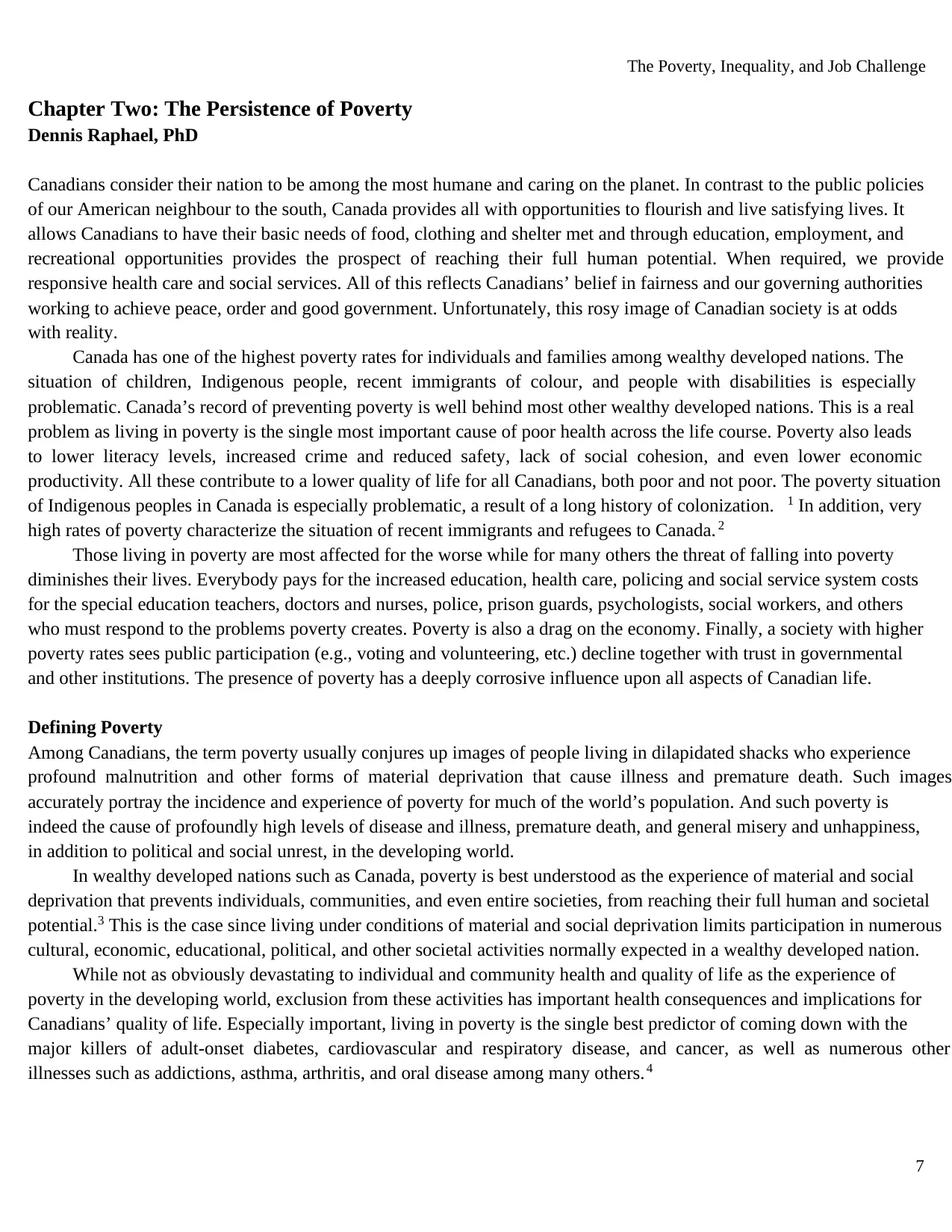
The Poverty, Inequality, and Job Challenge
7
Chapter Two: The Persistence of Poverty
Dennis Raphael, PhD
Canadians consider their nation to be among the most humane and caring on the planet. In contrast to the public policies
of our American neighbour to the south, Canada provides all with opportunities to flourish and live satisfying lives. It
allows Canadians to have their basic needs of food, clothing and shelter met and through education, employment, and
recreational opportunities provides the prospect of reaching their full human potential. When required, we provide
responsive health care and social services. All of this reflects Canadians’ belief in fairness and our governing authorities
working to achieve peace, order and good government. Unfortunately, this rosy image of Canadian society is at odds
with reality.
Canada has one of the highest poverty rates for individuals and families among wealthy developed nations. The
situation of children, Indigenous people, recent immigrants of colour, and people with disabilities is especially
problematic. Canada’s record of preventing poverty is well behind most other wealthy developed nations. This is a real
problem as living in poverty is the single most important cause of poor health across the life course. Poverty also leads
to lower literacy levels, increased crime and reduced safety, lack of social cohesion, and even lower economic
productivity. All these contribute to a lower quality of life for all Canadians, both poor and not poor. The poverty situation
of Indigenous peoples in Canada is especially problematic, a result of a long history of colonization. 1 In addition, very
high rates of poverty characterize the situation of recent immigrants and refugees to Canada. 2
Those living in poverty are most affected for the worse while for many others the threat of falling into poverty
diminishes their lives. Everybody pays for the increased education, health care, policing and social service system costs
for the special education teachers, doctors and nurses, police, prison guards, psychologists, social workers, and others
who must respond to the problems poverty creates. Poverty is also a drag on the economy. Finally, a society with higher
poverty rates sees public participation (e.g., voting and volunteering, etc.) decline together with trust in governmental
and other institutions. The presence of poverty has a deeply corrosive influence upon all aspects of Canadian life.
Defining Poverty
Among Canadians, the term poverty usually conjures up images of people living in dilapidated shacks who experience
profound malnutrition and other forms of material deprivation that cause illness and premature death. Such images
accurately portray the incidence and experience of poverty for much of the world’s population. And such poverty is
indeed the cause of profoundly high levels of disease and illness, premature death, and general misery and unhappiness,
in addition to political and social unrest, in the developing world.
In wealthy developed nations such as Canada, poverty is best understood as the experience of material and social
deprivation that prevents individuals, communities, and even entire societies, from reaching their full human and societal
potential.3 This is the case since living under conditions of material and social deprivation limits participation in numerous
cultural, economic, educational, political, and other societal activities normally expected in a wealthy developed nation.
While not as obviously devastating to individual and community health and quality of life as the experience of
poverty in the developing world, exclusion from these activities has important health consequences and implications for
Canadians’ quality of life. Especially important, living in poverty is the single best predictor of coming down with the
major killers of adult-onset diabetes, cardiovascular and respiratory disease, and cancer, as well as numerous other
illnesses such as addictions, asthma, arthritis, and oral disease among many others.4
7
Chapter Two: The Persistence of Poverty
Dennis Raphael, PhD
Canadians consider their nation to be among the most humane and caring on the planet. In contrast to the public policies
of our American neighbour to the south, Canada provides all with opportunities to flourish and live satisfying lives. It
allows Canadians to have their basic needs of food, clothing and shelter met and through education, employment, and
recreational opportunities provides the prospect of reaching their full human potential. When required, we provide
responsive health care and social services. All of this reflects Canadians’ belief in fairness and our governing authorities
working to achieve peace, order and good government. Unfortunately, this rosy image of Canadian society is at odds
with reality.
Canada has one of the highest poverty rates for individuals and families among wealthy developed nations. The
situation of children, Indigenous people, recent immigrants of colour, and people with disabilities is especially
problematic. Canada’s record of preventing poverty is well behind most other wealthy developed nations. This is a real
problem as living in poverty is the single most important cause of poor health across the life course. Poverty also leads
to lower literacy levels, increased crime and reduced safety, lack of social cohesion, and even lower economic
productivity. All these contribute to a lower quality of life for all Canadians, both poor and not poor. The poverty situation
of Indigenous peoples in Canada is especially problematic, a result of a long history of colonization. 1 In addition, very
high rates of poverty characterize the situation of recent immigrants and refugees to Canada. 2
Those living in poverty are most affected for the worse while for many others the threat of falling into poverty
diminishes their lives. Everybody pays for the increased education, health care, policing and social service system costs
for the special education teachers, doctors and nurses, police, prison guards, psychologists, social workers, and others
who must respond to the problems poverty creates. Poverty is also a drag on the economy. Finally, a society with higher
poverty rates sees public participation (e.g., voting and volunteering, etc.) decline together with trust in governmental
and other institutions. The presence of poverty has a deeply corrosive influence upon all aspects of Canadian life.
Defining Poverty
Among Canadians, the term poverty usually conjures up images of people living in dilapidated shacks who experience
profound malnutrition and other forms of material deprivation that cause illness and premature death. Such images
accurately portray the incidence and experience of poverty for much of the world’s population. And such poverty is
indeed the cause of profoundly high levels of disease and illness, premature death, and general misery and unhappiness,
in addition to political and social unrest, in the developing world.
In wealthy developed nations such as Canada, poverty is best understood as the experience of material and social
deprivation that prevents individuals, communities, and even entire societies, from reaching their full human and societal
potential.3 This is the case since living under conditions of material and social deprivation limits participation in numerous
cultural, economic, educational, political, and other societal activities normally expected in a wealthy developed nation.
While not as obviously devastating to individual and community health and quality of life as the experience of
poverty in the developing world, exclusion from these activities has important health consequences and implications for
Canadians’ quality of life. Especially important, living in poverty is the single best predictor of coming down with the
major killers of adult-onset diabetes, cardiovascular and respiratory disease, and cancer, as well as numerous other
illnesses such as addictions, asthma, arthritis, and oral disease among many others.4
Paraphrase This Document
Need a fresh take? Get an instant paraphrase of this document with our AI Paraphraser
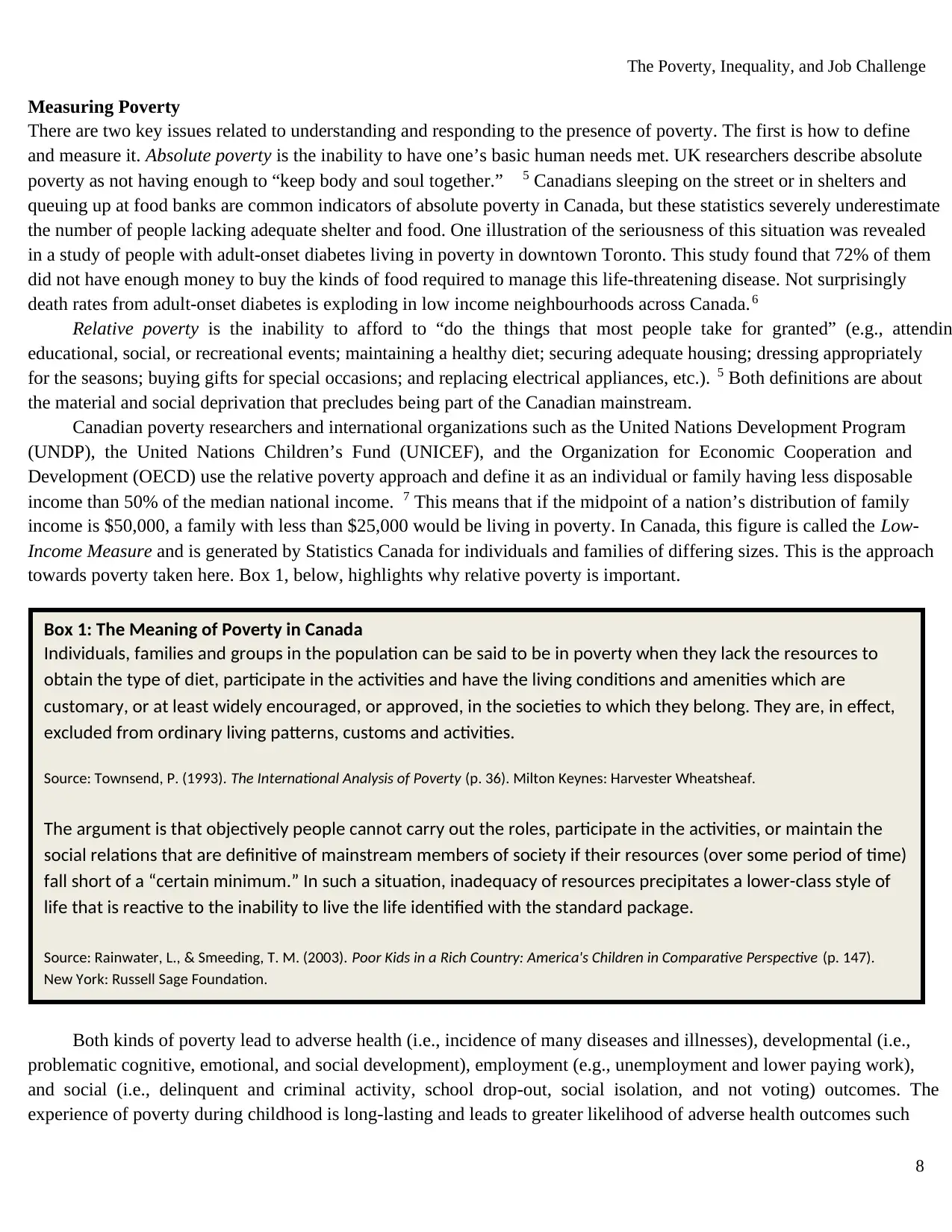
The Poverty, Inequality, and Job Challenge
8
Measuring Poverty
There are two key issues related to understanding and responding to the presence of poverty. The first is how to define
and measure it. Absolute poverty is the inability to have one’s basic human needs met. UK researchers describe absolute
poverty as not having enough to “keep body and soul together.” 5 Canadians sleeping on the street or in shelters and
queuing up at food banks are common indicators of absolute poverty in Canada, but these statistics severely underestimate
the number of people lacking adequate shelter and food. One illustration of the seriousness of this situation was revealed
in a study of people with adult-onset diabetes living in poverty in downtown Toronto. This study found that 72% of them
did not have enough money to buy the kinds of food required to manage this life-threatening disease. Not surprisingly
death rates from adult-onset diabetes is exploding in low income neighbourhoods across Canada.6
Relative poverty is the inability to afford to “do the things that most people take for granted” (e.g., attendin
educational, social, or recreational events; maintaining a healthy diet; securing adequate housing; dressing appropriately
for the seasons; buying gifts for special occasions; and replacing electrical appliances, etc.). 5 Both definitions are about
the material and social deprivation that precludes being part of the Canadian mainstream.
Canadian poverty researchers and international organizations such as the United Nations Development Program
(UNDP), the United Nations Children’s Fund (UNICEF), and the Organization for Economic Cooperation and
Development (OECD) use the relative poverty approach and define it as an individual or family having less disposable
income than 50% of the median national income. 7 This means that if the midpoint of a nation’s distribution of family
income is $50,000, a family with less than $25,000 would be living in poverty. In Canada, this figure is called the Low-
Income Measure and is generated by Statistics Canada for individuals and families of differing sizes. This is the approach
towards poverty taken here. Box 1, below, highlights why relative poverty is important.
Both kinds of poverty lead to adverse health (i.e., incidence of many diseases and illnesses), developmental (i.e.,
problematic cognitive, emotional, and social development), employment (e.g., unemployment and lower paying work),
and social (i.e., delinquent and criminal activity, school drop-out, social isolation, and not voting) outcomes. The
experience of poverty during childhood is long-lasting and leads to greater likelihood of adverse health outcomes such
Box 1: The Meaning of Poverty in Canada
Individuals, families and groups in the population can be said to be in poverty when they lack the resources to
obtain the type of diet, participate in the activities and have the living conditions and amenities which are
customary, or at least widely encouraged, or approved, in the societies to which they belong. They are, in effect,
excluded from ordinary living patterns, customs and activities.
Source: Townsend, P. (1993). The International Analysis of Poverty (p. 36). Milton Keynes: Harvester Wheatsheaf.
The argument is that objectively people cannot carry out the roles, participate in the activities, or maintain the
social relations that are definitive of mainstream members of society if their resources (over some period of time)
fall short of a “certain minimum.” In such a situation, inadequacy of resources precipitates a lower-class style of
life that is reactive to the inability to live the life identified with the standard package.
Source: Rainwater, L., & Smeeding, T. M. (2003). Poor Kids in a Rich Country: America's Children in Comparative Perspective (p. 147).
New York: Russell Sage Foundation.
8
Measuring Poverty
There are two key issues related to understanding and responding to the presence of poverty. The first is how to define
and measure it. Absolute poverty is the inability to have one’s basic human needs met. UK researchers describe absolute
poverty as not having enough to “keep body and soul together.” 5 Canadians sleeping on the street or in shelters and
queuing up at food banks are common indicators of absolute poverty in Canada, but these statistics severely underestimate
the number of people lacking adequate shelter and food. One illustration of the seriousness of this situation was revealed
in a study of people with adult-onset diabetes living in poverty in downtown Toronto. This study found that 72% of them
did not have enough money to buy the kinds of food required to manage this life-threatening disease. Not surprisingly
death rates from adult-onset diabetes is exploding in low income neighbourhoods across Canada.6
Relative poverty is the inability to afford to “do the things that most people take for granted” (e.g., attendin
educational, social, or recreational events; maintaining a healthy diet; securing adequate housing; dressing appropriately
for the seasons; buying gifts for special occasions; and replacing electrical appliances, etc.). 5 Both definitions are about
the material and social deprivation that precludes being part of the Canadian mainstream.
Canadian poverty researchers and international organizations such as the United Nations Development Program
(UNDP), the United Nations Children’s Fund (UNICEF), and the Organization for Economic Cooperation and
Development (OECD) use the relative poverty approach and define it as an individual or family having less disposable
income than 50% of the median national income. 7 This means that if the midpoint of a nation’s distribution of family
income is $50,000, a family with less than $25,000 would be living in poverty. In Canada, this figure is called the Low-
Income Measure and is generated by Statistics Canada for individuals and families of differing sizes. This is the approach
towards poverty taken here. Box 1, below, highlights why relative poverty is important.
Both kinds of poverty lead to adverse health (i.e., incidence of many diseases and illnesses), developmental (i.e.,
problematic cognitive, emotional, and social development), employment (e.g., unemployment and lower paying work),
and social (i.e., delinquent and criminal activity, school drop-out, social isolation, and not voting) outcomes. The
experience of poverty during childhood is long-lasting and leads to greater likelihood of adverse health outcomes such
Box 1: The Meaning of Poverty in Canada
Individuals, families and groups in the population can be said to be in poverty when they lack the resources to
obtain the type of diet, participate in the activities and have the living conditions and amenities which are
customary, or at least widely encouraged, or approved, in the societies to which they belong. They are, in effect,
excluded from ordinary living patterns, customs and activities.
Source: Townsend, P. (1993). The International Analysis of Poverty (p. 36). Milton Keynes: Harvester Wheatsheaf.
The argument is that objectively people cannot carry out the roles, participate in the activities, or maintain the
social relations that are definitive of mainstream members of society if their resources (over some period of time)
fall short of a “certain minimum.” In such a situation, inadequacy of resources precipitates a lower-class style of
life that is reactive to the inability to live the life identified with the standard package.
Source: Rainwater, L., & Smeeding, T. M. (2003). Poor Kids in a Rich Country: America's Children in Comparative Perspective (p. 147).
New York: Russell Sage Foundation.
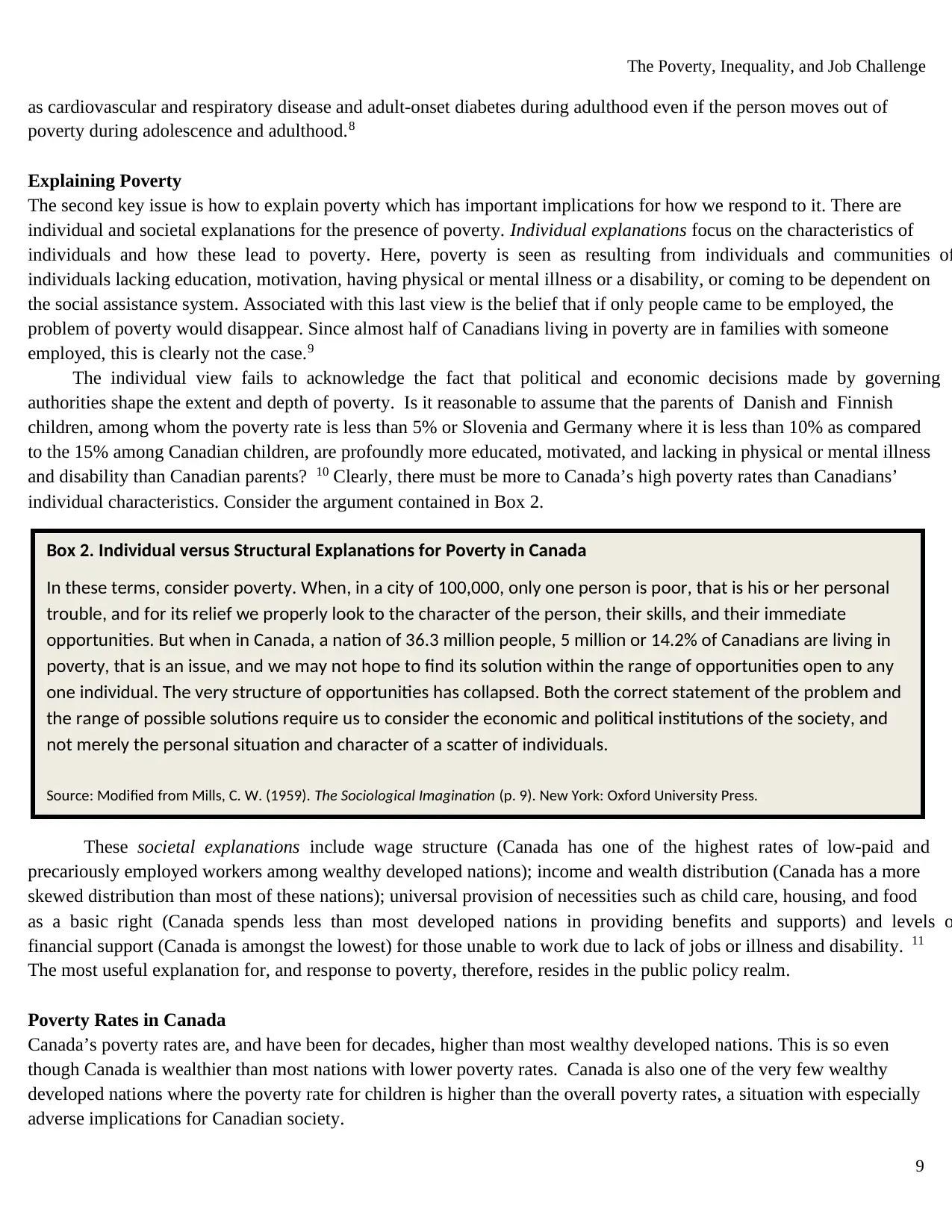
The Poverty, Inequality, and Job Challenge
9
as cardiovascular and respiratory disease and adult-onset diabetes during adulthood even if the person moves out of
poverty during adolescence and adulthood.8
Explaining Poverty
The second key issue is how to explain poverty which has important implications for how we respond to it. There are
individual and societal explanations for the presence of poverty. Individual explanations focus on the characteristics of
individuals and how these lead to poverty. Here, poverty is seen as resulting from individuals and communities of
individuals lacking education, motivation, having physical or mental illness or a disability, or coming to be dependent on
the social assistance system. Associated with this last view is the belief that if only people came to be employed, the
problem of poverty would disappear. Since almost half of Canadians living in poverty are in families with someone
employed, this is clearly not the case.9
The individual view fails to acknowledge the fact that political and economic decisions made by governing
authorities shape the extent and depth of poverty. Is it reasonable to assume that the parents of Danish and Finnish
children, among whom the poverty rate is less than 5% or Slovenia and Germany where it is less than 10% as compared
to the 15% among Canadian children, are profoundly more educated, motivated, and lacking in physical or mental illness
and disability than Canadian parents? 10 Clearly, there must be more to Canada’s high poverty rates than Canadians’
individual characteristics. Consider the argument contained in Box 2.
These societal explanations include wage structure (Canada has one of the highest rates of low-paid and
precariously employed workers among wealthy developed nations); income and wealth distribution (Canada has a more
skewed distribution than most of these nations); universal provision of necessities such as child care, housing, and food
as a basic right (Canada spends less than most developed nations in providing benefits and supports) and levels o
financial support (Canada is amongst the lowest) for those unable to work due to lack of jobs or illness and disability. 11
The most useful explanation for, and response to poverty, therefore, resides in the public policy realm.
Poverty Rates in Canada
Canada’s poverty rates are, and have been for decades, higher than most wealthy developed nations. This is so even
though Canada is wealthier than most nations with lower poverty rates. Canada is also one of the very few wealthy
developed nations where the poverty rate for children is higher than the overall poverty rates, a situation with especially
adverse implications for Canadian society.
Box 2. Individual versus Structural Explanations for Poverty in Canada
In these terms, consider poverty. When, in a city of 100,000, only one person is poor, that is his or her personal
trouble, and for its relief we properly look to the character of the person, their skills, and their immediate
opportunities. But when in Canada, a nation of 36.3 million people, 5 million or 14.2% of Canadians are living in
poverty, that is an issue, and we may not hope to find its solution within the range of opportunities open to any
one individual. The very structure of opportunities has collapsed. Both the correct statement of the problem and
the range of possible solutions require us to consider the economic and political institutions of the society, and
not merely the personal situation and character of a scatter of individuals.
Source: Modified from Mills, C. W. (1959). The Sociological Imagination (p. 9). New York: Oxford University Press.
9
as cardiovascular and respiratory disease and adult-onset diabetes during adulthood even if the person moves out of
poverty during adolescence and adulthood.8
Explaining Poverty
The second key issue is how to explain poverty which has important implications for how we respond to it. There are
individual and societal explanations for the presence of poverty. Individual explanations focus on the characteristics of
individuals and how these lead to poverty. Here, poverty is seen as resulting from individuals and communities of
individuals lacking education, motivation, having physical or mental illness or a disability, or coming to be dependent on
the social assistance system. Associated with this last view is the belief that if only people came to be employed, the
problem of poverty would disappear. Since almost half of Canadians living in poverty are in families with someone
employed, this is clearly not the case.9
The individual view fails to acknowledge the fact that political and economic decisions made by governing
authorities shape the extent and depth of poverty. Is it reasonable to assume that the parents of Danish and Finnish
children, among whom the poverty rate is less than 5% or Slovenia and Germany where it is less than 10% as compared
to the 15% among Canadian children, are profoundly more educated, motivated, and lacking in physical or mental illness
and disability than Canadian parents? 10 Clearly, there must be more to Canada’s high poverty rates than Canadians’
individual characteristics. Consider the argument contained in Box 2.
These societal explanations include wage structure (Canada has one of the highest rates of low-paid and
precariously employed workers among wealthy developed nations); income and wealth distribution (Canada has a more
skewed distribution than most of these nations); universal provision of necessities such as child care, housing, and food
as a basic right (Canada spends less than most developed nations in providing benefits and supports) and levels o
financial support (Canada is amongst the lowest) for those unable to work due to lack of jobs or illness and disability. 11
The most useful explanation for, and response to poverty, therefore, resides in the public policy realm.
Poverty Rates in Canada
Canada’s poverty rates are, and have been for decades, higher than most wealthy developed nations. This is so even
though Canada is wealthier than most nations with lower poverty rates. Canada is also one of the very few wealthy
developed nations where the poverty rate for children is higher than the overall poverty rates, a situation with especially
adverse implications for Canadian society.
Box 2. Individual versus Structural Explanations for Poverty in Canada
In these terms, consider poverty. When, in a city of 100,000, only one person is poor, that is his or her personal
trouble, and for its relief we properly look to the character of the person, their skills, and their immediate
opportunities. But when in Canada, a nation of 36.3 million people, 5 million or 14.2% of Canadians are living in
poverty, that is an issue, and we may not hope to find its solution within the range of opportunities open to any
one individual. The very structure of opportunities has collapsed. Both the correct statement of the problem and
the range of possible solutions require us to consider the economic and political institutions of the society, and
not merely the personal situation and character of a scatter of individuals.
Source: Modified from Mills, C. W. (1959). The Sociological Imagination (p. 9). New York: Oxford University Press.
⊘ This is a preview!⊘
Do you want full access?
Subscribe today to unlock all pages.

Trusted by 1+ million students worldwide
1 out of 72
Your All-in-One AI-Powered Toolkit for Academic Success.
+13062052269
info@desklib.com
Available 24*7 on WhatsApp / Email
![[object Object]](/_next/static/media/star-bottom.7253800d.svg)
Unlock your academic potential
Copyright © 2020–2025 A2Z Services. All Rights Reserved. Developed and managed by ZUCOL.